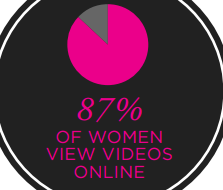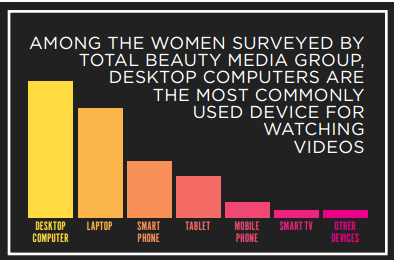Content marketing has already emerged as a prominent component to any promotional campaign, and the practice thrives on diverse media offerings. For example, video marketing – a growing trend for brands across all business sectors – provides marketers with opportunities to create interactive experiences for prospective and current customers. According to the Content Marketing Institute, 70 percent of B2Bs and B2Cs already use video content to engage with consumers, and a Total Beauty Media Group report shows that visual media resonates with female audiences.
Who’s watching online video content?
 Approximately 87 percent of women surveyed for the “What Women Watch” study indicated that they view video content online. These female consumers also prefer to engage with visual media on their desktop computers more than on laptops and mobile devices. The report suggested women enjoy the comforts of watching content on larger screens. They also like to avoid using data-plan minutes.
Approximately 87 percent of women surveyed for the “What Women Watch” study indicated that they view video content online. These female consumers also prefer to engage with visual media on their desktop computers more than on laptops and mobile devices. The report suggested women enjoy the comforts of watching content on larger screens. They also like to avoid using data-plan minutes.
Millennial women (aged 25 to 34), however, are 12 percent less likely to watch video content from their desktop computers and 10 percent more likely to view visual media from their smartphones. Both older and younger women would choose free video content over premium options.
“They don’t necessarily want to engage in branded content,” Ethelbert Williams, head of marketing at Total Beauty Media Group, said to ClickZ. “They want to watch on their terms…wherever they want, without being interrupted.”
How often and what type of video content do women want?
 The study revealed that more than 30 percent of Millennial women consume over 30 minutes of online video content per day. Williams notes that younger female audiences are willing to sit down and engage with branded content. However, marketers should be wary of pre-roll ads when attempting to target women with video media.
The study revealed that more than 30 percent of Millennial women consume over 30 minutes of online video content per day. Williams notes that younger female audiences are willing to sit down and engage with branded content. However, marketers should be wary of pre-roll ads when attempting to target women with video media.
Nearly 80 percent of women (both Millennials and Boomers) said pre-roll ads annoy them. In fact, these consumers prefer engaging with and sharing content from trusted brands, even if they have to submit contact information or answer a short survey to unlock content.
As for when brands should target various female audiences, the study shows that Millennials and Boomers access content at different times of the day. Boomers watch video content in the morning, while Millennials check updates throughout the day, spending the most time with video between 5 p.m. and 10 p.m. YouTube might be the ideal way to reach wider female audiences – 60 percent of Millennials and 40 percent of Young Boomers subscribe to channels on the social site.




